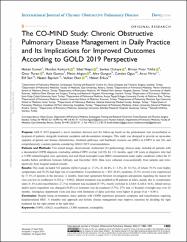The CO-MIND study: Chronic obstructive pulmonary disease management in daily practice and Its implications for improved outcomes according to GOLD 2019 perspective

Göster/
Erişim
info:eu-repo/semantics/openAccessTarih
2022Yazar
Günen, HakanKöktürk, Nurdan
Naycı, Sibel
Özkaya, Şevket
Yıldız, Pınar Birsen
Turan, Onur
Gümüş, Aziz
Akgün, Metin
Gürgün, Alev
Oğuş, Candan
Mirici, Arzu
Şen, Elif
Bayram, Nazan
Eken, Volkan
Erkuş, Hakan
Üst veri
Tüm öğe kaydını gösterKünye
Gunen, H., Kokturk, N., Naycı, S., Ozkaya, S., Yıldız, B. P., Turan, O., Gumus, A., Akgun, M., Gurgun, A., Ogus, C., Mirici, A., Sen, E., Bayram, N., Eken, V., & Erkus, H. (2022). The CO-MIND Study: Chronic Obstructive Pulmonary Disease Management in Daily Practice and Its Implications for Improved Outcomes According to GOLD 2019 Perspective. International journal of chronic obstructive pulmonary disease, 17, 1883–1895. https://doi.org/10.2147/COPD.S372439Özet
Purpose: GOLD 2019 proposed a novel treatment decision tool for follow-up based on the predominant trait (exacerbation or dyspnea) of patients, alongside treatment escalation and de-escalation strategies. This study was designed to provide an up-to-date snapshot of patient and disease characteristics, treatment pathways, and healthcare resource use (HRU) in COPD in real life, and comprehensively examine patients considering GOLD 2019 recommendations.Patients and Methods: This mixed design, observational, multicenter (14 pulmonology clinics) study included all patients with a documented COPD diagnosis (excluding asthma-COPD overlap [ACO]) for >12 months, aged >40 years at diagnosis who had a COPD-related hospital visit, spirometry test and blood eosinophil count (BEC) measurement under stable conditions within the 12 months before enrollment between February and December 2020. Data were collected cross-sectionally from patients and retro-spectively from hospital medical records. Results: This study included 522 patients (GOLD group A: 17.2%, B: 46.4%, C: 3.3%, D: 33.1%), of whom 79.5% were highly symptomatic and 36.2% had high risk of exacerbation. Exacerbations (n = 832; 46.6% moderate, 25.5% severe) were experienced by 57.5% of patients in the previous 12 months. Inter-rater agreement between investigators and patients regarding the reason for visit was low (Kappa coefficient: 0.338, p = 0.001). Inhaled treatment was modified in 88 patients at index, mainly due to symptomatic state (31.8%) and exacerbations (27.3%); treatment was escalated (57.9%, mainly switched to LABA+LAMA+ICS), inhaler device and/or active ingredient was changed (36.4%) or treatment was de-escalated (5.7%). 27% had >1 hospital overnight stay over 12 months. Emergency department visits and days with limitation of daily activities were higher in group D (p < 0.001). Conclusion: Despite being on-treatment, many patients with COPD experience persistent symptoms and exacerbations requiring hospital-related HRU. A treatable trait approach and holistic disease management may improve outcomes by deciding the right treatment for the right patient at the right time.

















